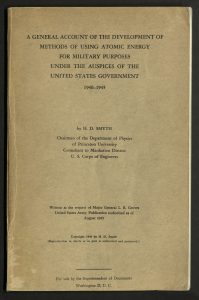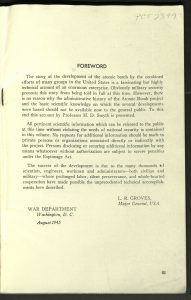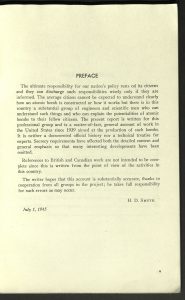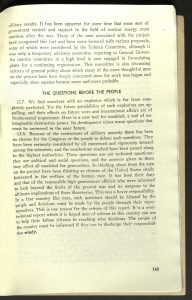Tags
Albert Einstein, Army Corps of Engineers, atomic energy, electromagnetism, fission, Franklin D. Roosevelt, General Leslie R. Groves, Henry De Wolf Smyth, Hiroshima, isotopes, Japan, Manhattan Project, Metallurgical Laboratory, military, Nagasaki, neutrons, nuclear weapon, physics, Princeton, science, Smyth Report, United States, United States War Department, University of Chicago, uranium, war, weapons
“These questions are not technical questions; they are political and social questions, and the answers given to them may affect all mankind for generations. In thinking about them the men on the project have been thinking as citizens of the United States vitally interested in the welfare of the human race. It has been their duty and that of the responsible high government officials who were informed to look beyond the limits of the present war and its weapons to the ultimate implications of these discoveries. This was a heavy responsibility. In a free country like ours, such questions should be debated by the people and decisions must be made by the people through their representatives. This is one reason for the release of this report. It is a semi-technical report which it is hoped men of science in this country can use to help their fellow citizens in reaching wise decisions. The people of the country must be informed if they are to discharge their responsibilities wisely”
— Henry De Wolf Smyth
A GENERAL ACCOUNT OF THE DEVELOPMENT OF METHODS OF USING ATOMIC ENERGY FOR MILITARY PURPOSES UNDER THE AUSPICES OF THE UNITED STATES GOVERNMENT, 1940-1945
Henry De Wolf Smyth (1898- 1986)
Washington, D. C: U. S. Govt. Print. Off., 1945
First edition
On August 6, 1945 the United States government dropped a uranium bomb on Hiroshima, Japan. One week later, after a second bomb was dropped on Nagasaki, Japan, the United States War Department issued an official account of the Manhattan Project which produced the bombs, written by Princeton physicist Henry D. Smyth.
The program to develop a nuclear weapon had its origins in 1939, when a group of scientists, including Albert Einstein, apprised President Franklin D. Roosevelt of the vast destructive power that could be unleashed by the recently-discovered fission of uranium. By mid-1942 a top-secret program had been instituted under the Army Corps of Engineers’ Manhattan District. Smyth’s involvement began with his research at Princeton, where he headed the physics department, on electromagnetic methods of separating uranium isotopes. In 1943 he was appointed associate director of the Metallurgical Laboratory at the University of Chicago, working on the production of the heavy water needed to regulate the speed of neutrons in a chain reaction.
In April 1944 General Leslie R. Groves, chief of the Manhattan Project, asked Smyth to prepare a report on the project for release after the expected deployment of the bomb. The press release became known simply as the “Smyth Report.”





You must be logged in to post a comment.